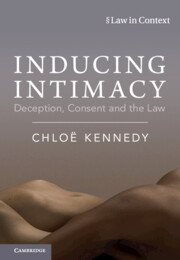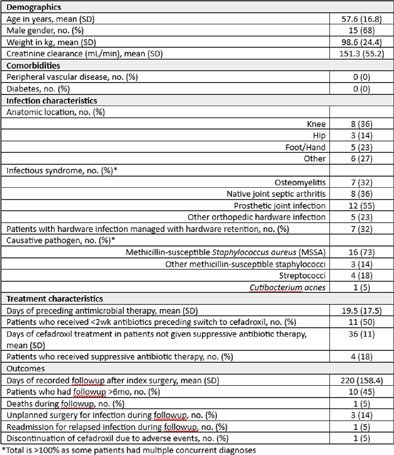2926 results

Inducing Intimacy
- Deception, Consent and the Law
- Coming soon
-
- Expected online publication date:
- November 2024
- Print publication:
- 30 November 2024
-
- Book
- Export citation
Cefadroxil is an option for Gram-positive bone and joint infections in adults
-
- Journal:
- Antimicrobial Stewardship & Healthcare Epidemiology / Volume 4 / Issue S1 / July 2024
- Published online by Cambridge University Press:
- 16 September 2024, p. s34
-
- Article
-
- You have access
- Open access
- Export citation
Change in Quality of Life After the Relocation of a National Forensic Hospital: A Dundrum Forensic Redevelopment Evaluation Study (D-FOREST)
-
- Journal:
- European Psychiatry / Volume 67 / Issue S1 / April 2024
- Published online by Cambridge University Press:
- 27 August 2024, p. S578
-
- Article
-
- You have access
- Open access
- Export citation
Insight into Illness Among Inpatients in a National Forensic Mental Health Service: A Dundrum Forensic Redevelopment Evaluation Study (D-FOREST)
-
- Journal:
- European Psychiatry / Volume 67 / Issue S1 / April 2024
- Published online by Cambridge University Press:
- 27 August 2024, pp. S154-S155
-
- Article
-
- You have access
- Open access
- Export citation
Morphodynamics and management challenges for beaches in modified estuaries and bays
-
- Journal:
- Cambridge Prisms: Coastal Futures / Volume 2 / 2024
- Published online by Cambridge University Press:
- 27 August 2024, e11
-
- Article
-
- You have access
- Open access
- HTML
- Export citation
Admissions to the National Forensic Mental Health Service Anteceding and Succeeding Its Relocation: A Dundrum Forensic Redevelopment Evaluation Study (D-FOREST)
-
- Journal:
- BJPsych Open / Volume 10 / Issue S1 / June 2024
- Published online by Cambridge University Press:
- 01 August 2024, p. S47
-
- Article
-
- You have access
- Open access
- Export citation
Change in Quality of Life After Moving a National Forensic Mental Health Service: A Dundrum Forensic Redevelopment Evaluation Study (D-FOREST)
-
- Journal:
- BJPsych Open / Volume 10 / Issue S1 / June 2024
- Published online by Cambridge University Press:
- 01 August 2024, p. S62
-
- Article
-
- You have access
- Open access
- Export citation
Sorption of Water at High Temperatures on Certain Clay Mineral Surfaces. Correlation with Lattice Fluoride
-
- Journal:
- Clays and Clay Minerals / Volume 15 / February 1967
- Published online by Cambridge University Press:
- 01 July 2024, pp. 103-117
-
- Article
-
- You have access
- Export citation
Meritocracy in psychiatry training: abandoning the common good
-
- Journal:
- The British Journal of Psychiatry / Volume 225 / Issue 1 / July 2024
- Published online by Cambridge University Press:
- 02 September 2024, pp. 290-291
- Print publication:
- July 2024
-
- Article
-
- You have access
- HTML
- Export citation
Copyright page
-
- Book:
- Seminars in Forensic Psychiatry
- Published online:
- 06 June 2024
- Print publication:
- 13 June 2024, pp iv-iv
-
- Chapter
- Export citation
Appendix 16.4 - Declaration of Compliance with Duties of Expert
- from Chapter 16 - Forensic Aspects of Medical Negligence
-
- Book:
- Seminars in Forensic Psychiatry
- Published online:
- 06 June 2024
- Print publication:
- 13 June 2024, pp 377-378
-
- Chapter
- Export citation
Chapter 6 - Expertise, Structured Professional Judgement and Risk Assessment
-
-
- Book:
- Seminars in Forensic Psychiatry
- Published online:
- 06 June 2024
- Print publication:
- 13 June 2024, pp 141-175
-
- Chapter
- Export citation
Chapter 2 - Violence and Mental Disorder
-
-
- Book:
- Seminars in Forensic Psychiatry
- Published online:
- 06 June 2024
- Print publication:
- 13 June 2024, pp 36-64
-
- Chapter
- Export citation
Contents
-
- Book:
- Seminars in Forensic Psychiatry
- Published online:
- 06 June 2024
- Print publication:
- 13 June 2024, pp v-vi
-
- Chapter
- Export citation
Appendix 16.1 - Template for Consent to Proceed with Psychiatric Evaluation
- from Chapter 16 - Forensic Aspects of Medical Negligence
-
- Book:
- Seminars in Forensic Psychiatry
- Published online:
- 06 June 2024
- Print publication:
- 13 June 2024, pp 375-375
-
- Chapter
- Export citation
Chapter 7 - Models of Care in Forensic Psychiatry
-
-
- Book:
- Seminars in Forensic Psychiatry
- Published online:
- 06 June 2024
- Print publication:
- 13 June 2024, pp 176-207
-
- Chapter
- Export citation
Contributors
-
- Book:
- Seminars in Forensic Psychiatry
- Published online:
- 06 June 2024
- Print publication:
- 13 June 2024, pp vii-x
-
- Chapter
- Export citation
Foreword
-
- Book:
- Seminars in Forensic Psychiatry
- Published online:
- 06 June 2024
- Print publication:
- 13 June 2024, pp xi-xii
-
- Chapter
- Export citation
Appendix 16.3 - Template for Medical Negligence Expert Opinion
- from Chapter 16 - Forensic Aspects of Medical Negligence
-
- Book:
- Seminars in Forensic Psychiatry
- Published online:
- 06 June 2024
- Print publication:
- 13 June 2024, pp 377-377
-
- Chapter
- Export citation
Appendix 16.2 - Medical Protection Society Guide to Writing an Expert Medical Report
- from Chapter 16 - Forensic Aspects of Medical Negligence
-
- Book:
- Seminars in Forensic Psychiatry
- Published online:
- 06 June 2024
- Print publication:
- 13 June 2024, pp 376-376
-
- Chapter
- Export citation


